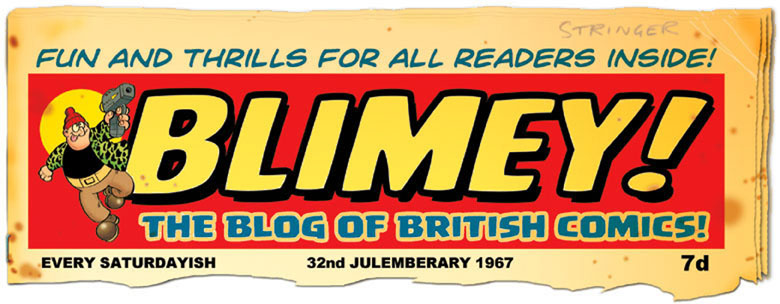I recently bought a run of issues of The Joker from 1929 so you can expect to see a few more samples on my blog from time to time. This is issue No.86, dated 22nd June 1929, the issue that kids would have been reading 86 years ago this week.
Published by The Amalgamated Press, the comic's format is typical of the early 20th Century: tabloid, no colour, 8 pages equally divided between comic strips and prose stories. Thanks to the research by the late Denis Gifford I'm able to identify the artists of these strips.
Firstly that cover strip. Very racist by today's standards, Jim Crow and Oliver Twitter are a typical twosome of comics of the time, unemployed, sometimes homeless, wandering from one situation to the next. The name Jim Crow is particularly jarring as it derives from the slang term describing anti-black laws in America. Despite some of it being uncomfortable to read today the strip has excellent artwork by Percy Cocking.
Inside, one of the text stories was Burke, Chief of Police, a complete mystery tale.
As with other comics of the time, he centre pages feature an array of short strips. Here are two of them, Our Wandering Boy by Albert Pease...
...and Tilly Tappit the Typist by Louis Briault. Note the blatant plug for two of The Joker's companion comics...
On the back page, The Cruise of the Winklepin by H.C. Milburn. It's yet another variation of the wandering twosome that had been popularised by Weary Willie and Tired Tim in Chips. This time the spin on the theme was that the wanderers had a boat.I know posts on pre-war comics aren't very popular amongst most visitors to this blog but I think it's important to show the history of British comics and to bring the work of those early artists to modern readers. I hope some of you enjoy seeing them anyway. Please leave a comment below with your thoughts/opinions.






10 comments:
For my money, keep posting them. I always enjoy seeing obscure old strips, even when they aren't my cup of tea stylistically.
I love the critters in the hut in the Winklepin story. The parrot is drawn so strangely that at first I thought he was one of them.
Thanks Smurfswacker. Yes, that parrot is very strange. Missing his feathers for some reason!
love Tilly's 20's outfit..
I liked the ending on Our wondering boy..
also lovely fun details throughout..
Yes, Tilly's hat would have been right up to date back then. Comics can often be a nice historical record of changing times, which is another reason I like these classics.
I usually find the stories from those times unreadable. Still, I do enjoy the strangeness of viewing the world of then. Despite it being just a stone's throw away in time, our tastes are world's apart. That makes it all the more fascinating.
Thanks for commenting, Chris. The strips in these pre-war comics are very formularised but it's the artwork and cultural references that appeal to me. (I'm afraid I never read the text stories.) I really like the art styles, although it's a pity the artists were told to follow a house style so closely.
Lew, I never thought about these being house styles...I guess I figured there was a "style of the times" that most cartoonists worked in. Did the various papers have "style-setter" artists whom the others were told to follow, like Marvel did with Kirby for so long?
Yes, very much so. Initially the artists on these early comics were encouraged to follow the style of Tom Browne, a very popular artist of the late 19th and early 20th Century who drew the Weary Wilie and Tired Tim cover strip for Chips. A couple decades later, in the 1930s, it was Roy Wilson's style they were asked to emulate, and then later still, in the 1960s, Leo Baxendale's style became the popular one to follow.
Some artists rigidly based their styles on those artists, while others were inspired by them but their own styles still shone through.
I much prefer reading and finding out about older, more obscure comics now than the more common stuff. Although maybe that's just because I've read so many...
Good to hear from you, George. It's a shame you closed down your blog as it was another source of info about British comics. Hope all's well with you.
Post a Comment